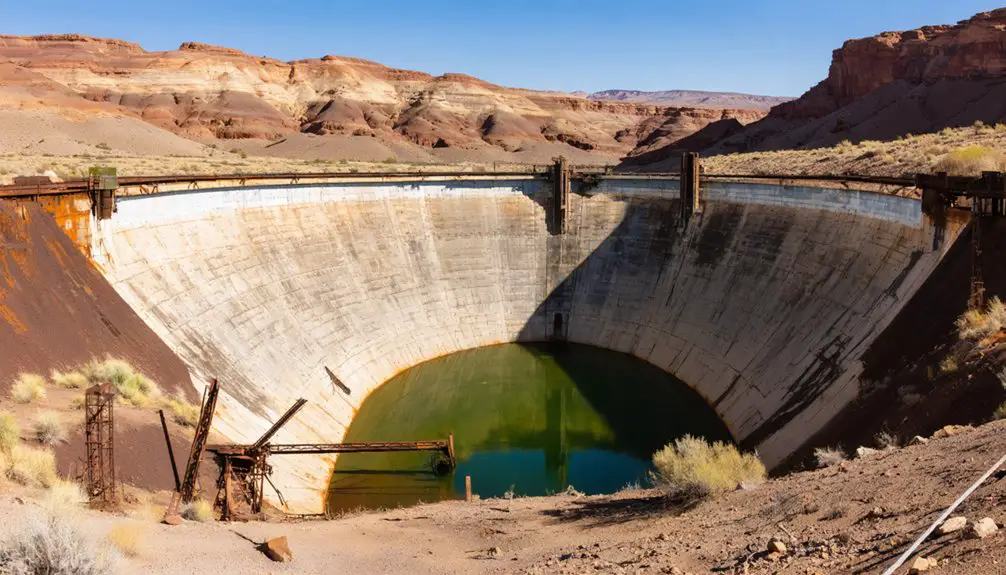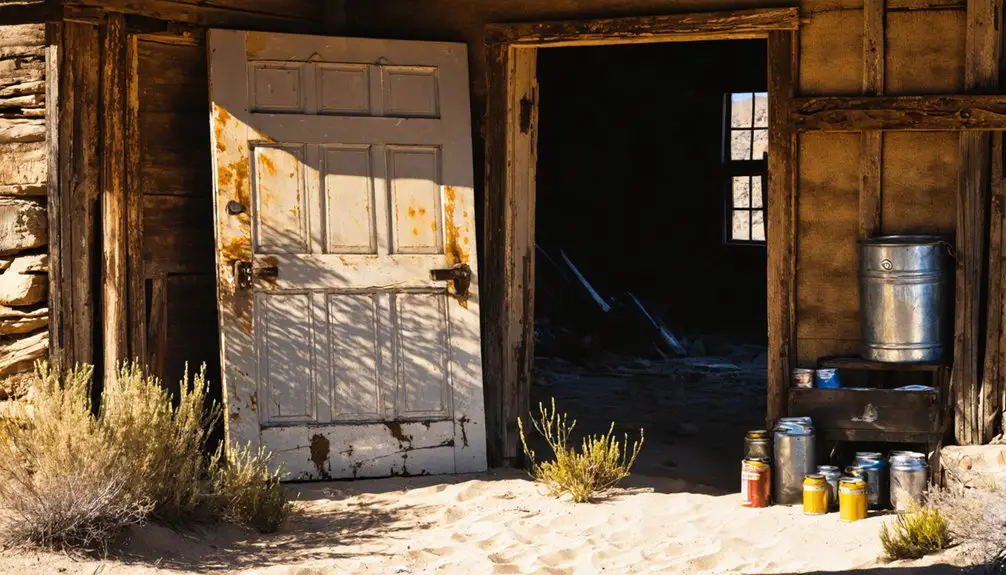You’ll find Ferguson, Nevada—later renamed Delamar—in the remnants of a once-thriving 1889 gold discovery at Monkeywrench Wash. After John Ferguson and Joseph Sharp’s initial find, Captain John DeLamar’s $150,000 investment in 1893 transformed the site into a booming mining town of 3,000 residents. The town produced $25 million in gold during its peak years, with modern ruins and mine shafts telling a deeper story of Nevada’s mining heritage.
Key Takeaways
- Originally named Ferguson in 1889 after discoverer John Ferguson, the mining town was later renamed Delamar in 1893.
- The town flourished after Captain John DeLamar invested $150,000, growing to over 3,000 residents with schools, churches, and saloons.
- From 1894 to 1900, the district produced approximately $25 million in gold, representing half of Nevada’s total ore output.
- Water challenges, including court-mandated population limits and infrastructure collapse, contributed to the town’s eventual decline.
- Today, the ghost town features weathered ruins, mine structures, and abandoned shafts, requiring 4×4 vehicles for access and careful exploration.
The Discovery of Gold in Monkeywrench Wash
While many Nevada gold discoveries sparked instant booms, the 1889 find in Monkeywrench Wash initially drew modest attention.
You’ll find that prospectors John Ferguson and Joseph Sharp made the pivotal discovery west of the existing Monkeywrench Mine, setting the stage for Nevada’s next gold rush. The site’s promising ore assays, ranging from $75 to $1,000 per ton, quickly caught the attention of miners from nearby Pioche.
The mining camp, first named Ferguson after its discoverer, marked the beginning of a significant mining legacy in this treeless, isolated region. Native rock buildings became the primary construction material as the settlement expanded. In 1893, the town was renamed after Joseph Delmar who invested $150,000 in the best mining claims.
Though the initial settlement remained small, you can trace how this discovery transformed the area, as word spread and prospectors from Pahranagat Valley uncovered additional gold deposits by 1890.
From Ferguson to Delamar: The Name Change
The small mining camp of Ferguson underwent a significant transformation in 1893 when Captain John DeLamar, a successful mining entrepreneur from Leadville, Colorado, purchased several of the district’s prime claims for $150,000.
While Ferguson’s origins trace back to the gold discoveries of John Ferguson and Joe Sharp in 1890-1891, DeLamar’s influence would forever change the area’s trajectory.
In 1894, he relocated the townsite and renamed it Delamar, marking the shift from a modest prospecting camp to a booming mining town. Under DeLamar’s ownership, you’d have witnessed the rapid development of infrastructure, including a 50-ton mill and a 12-mile water pipeline. The mining operations utilized a dry milling process that created dangerous silica dust throughout the town.
The town quickly grew to over 3,000 residents, boasting schools, churches, saloons, and an opera house, becoming Nevada’s leading gold producer. The mines’ success was so substantial that they generated over half of Nevada’s ore production during peak years.
Mining Operations and Production Peak
You’ll find the foundations of Delamar’s mining success in its robust infrastructure, which included a 12-mile water pipeline from Meadow Valley Wash and a fifty-ton stamp mill constructed in 1895.
Much like the gold vein discovery in Utah’s Cottonwood Heights that Brother Ferguson made years earlier, the district’s milling capacity expanded considerably with the addition of a 10-stamp mill at the April Fool mine in 1896, eventually reaching a peak processing capability of 260 tons of ore daily at the Delamar mill.
The sophisticated infrastructure enabled the district to produce more than half of Nevada’s total ore output between 1894 and 1900, yielding approximately $25 million in gold production.
Mining Infrastructure Development
Following Captain John De La Mar‘s acquisition of key claims in 1893, mining infrastructure expanded rapidly across Ferguson district, transforming small-scale prospecting into industrial-scale operations.
You’ll find the most significant advancement came in 1895 with the completion of a 50-ton mill, which quickly grew to process 260 tons of ore daily by 1896.
Mining technology advanced further with the addition of a 10-stamp mill at the April Fool mine.
The district’s lifeline was a sophisticated 12-mile water system featuring three booster stations that pumped from Meadow Valley Wash.
Ore transportation relied on mule teams traversing difficult 150-mile routes to Milford, Utah, as the region lacked rail access.
This complex infrastructure network, though challenging to maintain, supported the district’s transformation into Nevada’s leading gold producer.
The extensive mining operations were documented in detail by U.S. Geological Survey member Henry Ferguson, who studied the region’s structure and stratigraphy.
Daily Production Records
Between 1935 and 1940, Ferguson Mine’s production records show a concentrated period of activity under San Juan Ramsey Company’s lease, yielding approximately $107,000 in precious metals. According to the USGS data, the region saw significant mining activity throughout Nevada’s mineral development history.
You’ll find the daily output was influenced by the steep terrain of the Merced River canyon and the mine’s challenging vein structure, which required systematic tunneling for ideal mining efficiency. The mine’s advanced operations utilized five adit levels extending into the canyon wall for optimal ore extraction.
- The mine’s veins, ranging from 1 to 6 feet wide, yielded native gold and valuable sulfides including arsenopyrite and galena.
- Mining efficiency depended on maneuvering steeply dipping veins through rugged canyon walls.
- Daily production faced constraints from limited infrastructure and the remote location.
- The mine’s 4% sulfide concentration demanded intensive daily processing to extract valuable metals.
Life in a Remote Nevada Boomtown
Life in Nevada’s remote boomtowns embodied the quintessential American frontier experience, as thousands of fortune-seekers transformed barren desert landscapes into vibrant communities practically overnight.
You’d find yourself among a mainly male, transient population where community dynamics shifted as rapidly as mining fortunes. The local population grew explosively, as demonstrated by towns like Riolite reaching up to 10,000 inhabitants during peak times. These settlements attracted adventurous souls seeking wealth through resource extraction opportunities.
Despite their isolated locations, these towns offered surprising sophistication. You could deposit money in modern banks with time-locked vaults, walk on concrete sidewalks under electric lights, or choose from numerous businesses – from hotels to grocery stores.
Far from primitive outposts, Nevada’s boomtowns boasted modern amenities like electric lighting, secure banks, and bustling commercial districts.
Your social life would’ve revolved around the many saloons, while churches, theaters, and newspapers provided cultural touchstones.
Though mining drove the economy, you’d find work in various supporting industries, from assay offices to supply shops, all serving the steady stream of prospectors chasing their dreams in Nevada’s mineral-rich hills.
Water Challenges and Infrastructure

While Ferguson’s initial development showed promise, the town’s fate ultimately hinged on its precarious water situation.
Pacific Reclamation Company’s infrastructure projects, including dams and canals, initially supported both agriculture and residential needs. However, water rights disputes with downstream farmers led to strict population limits of 4,000 residents, severely constraining the town’s growth potential.
Your understanding of Ferguson’s water challenges deepens when you consider:
- The infrastructure’s vulnerability to drought exposed critical weaknesses in long-term planning
- Legal battles over water rights crushed hopes for expansion beyond court-mandated limits
- The combination of drought and restricted access broke the town’s infrastructure resilience
- Pacific Reclamation Company’s bankruptcy dealt the final blow to Ferguson’s water systems
These water challenges transformed a hopeful boomtown into another Nevada ghost town.
The Ghost Town’s Remaining Structures
Today’s visitors to Ferguson encounter a haunting collection of weathered ruins spread across miles of Nevada hillsides.
You’ll find scattered stone buildings and wooden mining structures that tell the story of this once-bustling mining district. While vandals have dismantled many stone buildings in search of valuables, you can still explore the remnants of mine entrances, mill operations, and stone huts near the former tent camp of Helene.
The remaining artifacts include decaying mine frames, tailings piles, and fragments of the “Ferguson Lode” newspaper. A small cemetery stands as a poignant reminder of the town’s inhabitants.
Despite ongoing structural decay, you’ll discover distinct zones of mining, residential, and industrial operations.
Exercise caution, as many structures are unstable, and mine workings are hazardous.
Modern Access and Safety Considerations

You’ll need a high-clearance or 4×4 vehicle to navigate the rough gravel roads leading to Ferguson, as passenger cars aren’t suitable for the challenging terrain.
While exploring the ghost town’s ruins, you must stay clear of the numerous abandoned mine shafts and tunnels that pose serious risks of collapse or injury.
Given the site’s remote location and lack of cell service, it’s critical you inform others of your travel plans and bring adequate supplies, including water, navigation tools, and emergency gear.
Road Access Requirements
Reaching Ferguson’s remote location requires careful consideration of road conditions and vehicle capabilities. The accessibility challenges you’ll face include unpaved terrain, rocky surfaces, and potential seasonal hazards that can affect your journey.
You’ll need a high-clearance or 4WD vehicle to navigate the rugged landscape safely.
- Your standard passenger car won’t cut it – rough terrain and poor road maintenance create risks of getting stuck or damaging your vehicle.
- Weather conditions can drastically change your route’s accessibility – be prepared for washouts during rain or snow closures.
- You’ll rarely find paved alternatives – expect to tackle mostly dirt roads with varying degrees of difficulty.
- Historic toll roads that once served the area have deteriorated into challenging paths that demand specialized vehicles.
Mine Safety Hazards
While accessing Ferguson requires careful vehicle consideration, the most serious risks await visitors at the mines themselves.
The abandoned mines contain deadly hazards including unstable explosives, toxic gases, and structurally compromised tunnels prone to mine collapse. You’ll encounter vertical shafts hundreds of feet deep, deteriorating timber supports, and dangerous wildlife that’s made these mines their home.
Old blasting caps and dynamite sticks remain volatile even decades later, capable of detonating if disturbed.
Though state programs work to secure roughly 754 dangerous mine sites annually, many remain open due to vandalism and deliberate reopening.
If you discover unsecured mine entrances, report their GPS coordinates to authorities rather than exploring them – the lack of proper ventilation and risk of cave-ins make amateur exploration potentially fatal.
Frequently Asked Questions
What Was the Average Salary of Miners in Ferguson During Peak Operations?
You’d have earned between $3-$6 daily as a Ferguson miner during peak operations, with mining wages varying based on ore yields and economic impact. Skilled positions could’ve commanded up to $10 daily.
How Many Children Attended the Ferguson School at Its Highest Enrollment?
You’ll find the school demographics data isn’t precisely documented, but given the town’s peak population of 3,000, educational impact suggests an estimated enrollment between 50-150 students during Ferguson school’s height.
Were There Any Major Crimes or Notable Lawmen in Ferguson?
You won’t find documented major crimes or famous lawmen in the historical records. Crime statistics and law enforcement details are scarce, with minimal peacekeeping likely handled by miners and private guards.
What Indigenous Tribes Inhabited the Area Before the Town’s Establishment?
You’d be amazed to know the Southern Paiute people dominated this vast territory, maintaining their historical significance as expert hunter-gatherers. They lived here for generations before settlers established the mining town.
Did Any Famous People Visit or Invest in Ferguson’s Mines?
You’ll find Captain Joseph Rafael De Lamar was the only major famous investor, purchasing claims for $150,000 in 1894. There’s no record of other celebrity visitors to Ferguson’s mines.
References
- https://www.legendsofamerica.com/nv-delamar/
- https://lincolncountynevada.com/exploring/wild-westing/ghost-towns/delamar-2/
- http://kensphotogallery.blogspot.com/2012/06/daytrip-delamar-ghost-town.html
- https://www.nvexpeditions.com/lincoln/delamar.php
- https://www.youtube.com/watch?v=CRD3WYYAdjI
- https://www.youtube.com/watch?v=ke9_cCYPJNs
- https://special.library.unlv.edu/ark:/62930/d1x63b862
- https://www.destination4x4.com/delamar-nevada-ghost-town/
- https://westernmininghistory.com/mine-detail/10222243/
- https://westernmininghistory.com/towns/nevada/delamar/



